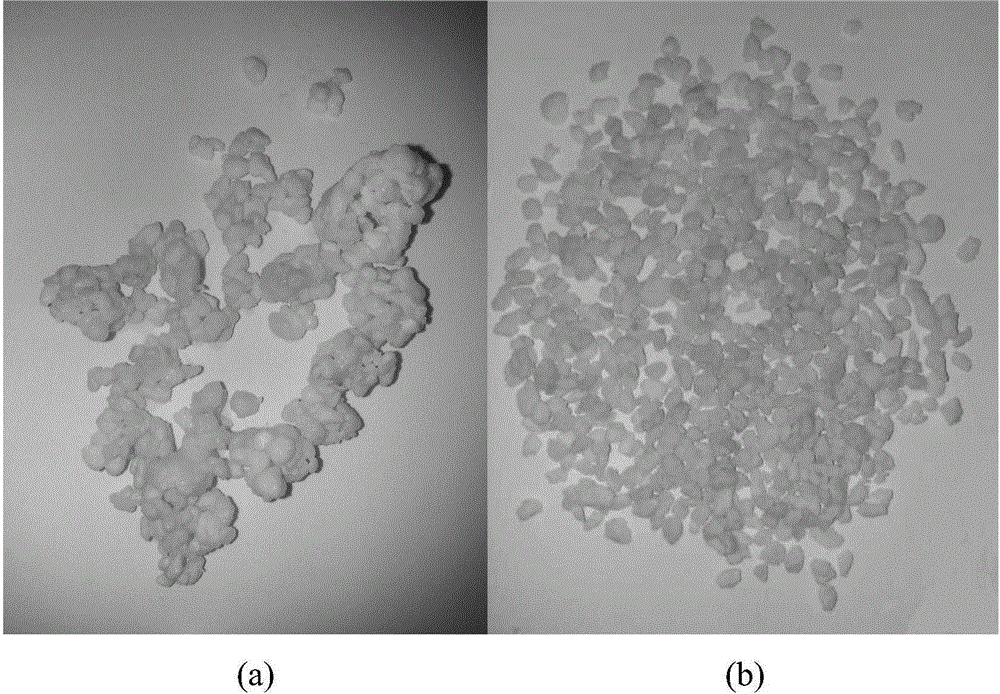A preparation method of porous medium composite phase change energy storage particles
A technology of composite phase change and porous media, applied in chemical instruments and methods, heat exchange materials, etc., can solve the problems of complex process, high cost, waste, etc., achieve simple process, convenient operation, and overcome easy agglomeration and agglomeration Effect
- Summary
- Abstract
- Description
- Claims
- Application Information
AI Technical Summary
Problems solved by technology
Method used
Image
Examples
Embodiment 1
[0022] Porous mineral medium composite phase change energy storage particles were prepared by using bentonite and paraffin. Wherein the paraffin phase transition temperature is 25°C, and the specific operations are as follows:
[0023] Melt the paraffin phase change material and preheat the bentonite in an oven at 40°C; mix and stir the two at this temperature, wherein the mass ratio of paraffin to bentonite is 2:1. After stirring evenly, let the two stand at this temperature for 2 hours to form composite phase-change particles; pour the uniformly mixed composite phase-change particles into the inlet of the fluidized bed, and pass cold air into the inlet. The temperature is 20°C, and the flow rate is 0.8 times of the particle suspension speed, so that the composite phase change energy storage particles are blown into the boiling state in the fluidized bed cylinder; after 30 minutes of operation, the discharge port is opened to allow the material to flow out. Through the analy...
Embodiment 2
[0025] Phase change energy storage particles were prepared by using open-pore expanded perlite and lauric acid-capric acid binary phase change materials. The specific operation is as follows:
[0026] Mix lauric acid and capric acid at a molar ratio of 6:4 and melt evenly to prepare a binary phase change material with a phase transition temperature of 28.3°C. The porous medium adopts open-pore expanded perlite. Mix the binary phase change material and the expanded pearl at a mass ratio of 1.8:1 at a temperature of 50°C and fully stir them, and let them stand at this temperature for 2 hours. The phase-change particles are sprayed to make them boil, the air velocity is adjusted to 1.1 times of the particle suspension velocity, the temperature of the cold air is 18°C, and the discharge port is opened after 10 minutes of operation to allow the recombined phase-change particles to flow out. The prepared particles such as figure 1 As shown, using the traditional method to compare...
Embodiment 3
[0028] Composite phase change energy storage particles were prepared by diatomite and lauric acid phase change materials. Among them, the phase transition temperature of lauric acid is 41°C, and the specific operation is as follows:
[0029] Melt lauric acid and mix it with diatomaceous earth at a mass ratio of 2:1, and mix and stir evenly at 80°C. After standing at this temperature for 0.5 hours, pour it into the inlet of the fluidized bed, and pass it into the Cold air, the temperature of the cold air is 11°C, and the flow rate of the cold air is adjusted to 0.6 times of the particle suspension speed, and it runs for 20 minutes. Finally, dry and uniformly dispersed diatomite-based composite phase-change energy storage particles are prepared. The diatomaceous earth-based composite phase-change particles prepared by the same method have larger retention capacity and better performance than the phase-change materials prepared by the traditional method.
[0030] It should be p...
PUM
| Property | Measurement | Unit |
|---|---|---|
| phase transition temperature | aaaaa | aaaaa |
Abstract
Description
Claims
Application Information
 Login to View More
Login to View More - R&D
- Intellectual Property
- Life Sciences
- Materials
- Tech Scout
- Unparalleled Data Quality
- Higher Quality Content
- 60% Fewer Hallucinations
Browse by: Latest US Patents, China's latest patents, Technical Efficacy Thesaurus, Application Domain, Technology Topic, Popular Technical Reports.
© 2025 PatSnap. All rights reserved.Legal|Privacy policy|Modern Slavery Act Transparency Statement|Sitemap|About US| Contact US: help@patsnap.com

